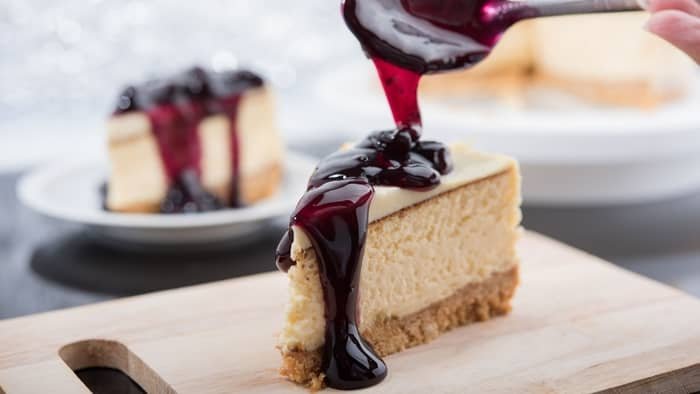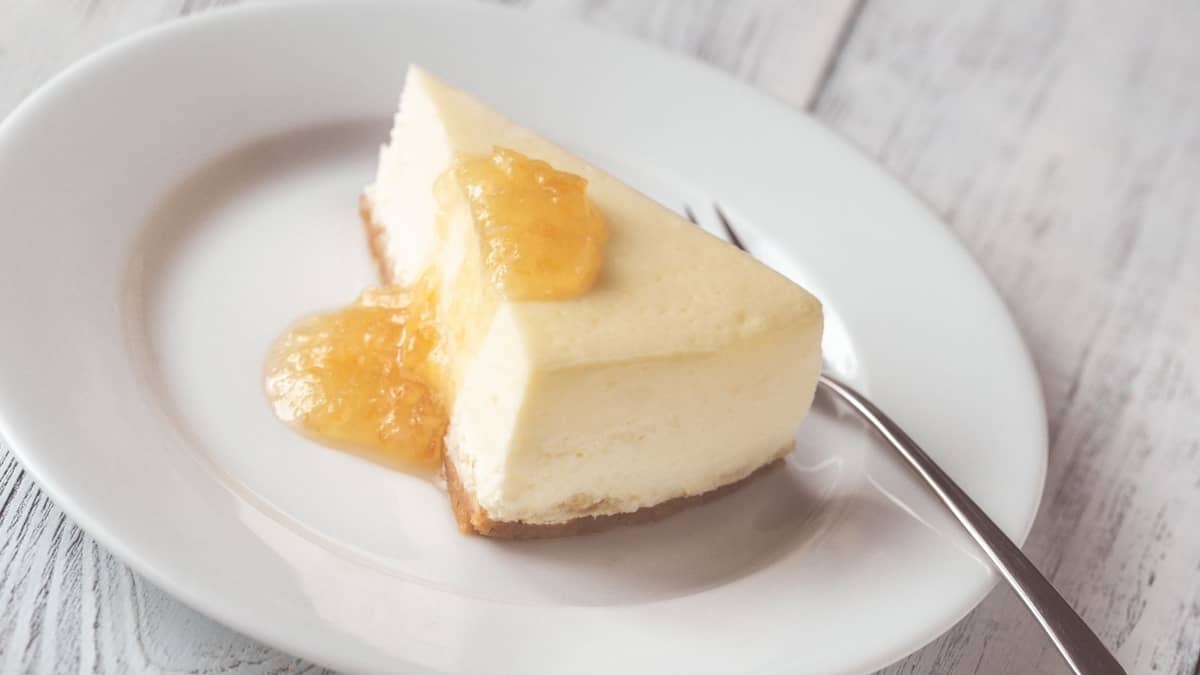By Lindy Van Schalkwyk, last updated on October 3, 2024
Are you struggling to figure out why the recipe you are using is making your cheesecake too dense? We’ve got all the answers and solutions for you!
While many cheesecakes have a light, creamy, and fluffy texture, they can also be on the denser side of things. The problem, however, comes in when your cheesecake is fat too dense. It almost has a rubber-like consistency! But, not many people can figure out exactly why this happens, let alone how to prevent it! That’s where this article is extremely useful! We have broken down exactly the causes of dense cheesecake and how to prevent and fix them.
What Makes Cheesecake Too Dense?
Before looking at why and how cheesecakes become too dense, it is important to fully understand what affects the texture of cheesecakes. Unfortunately, essentially every step of the cheesecake-making process will affect the final texture of your product.
The type of ingredients you use, the way you process them, how you make the batter, and even how and how long you bake the cheesecake for. These are all crucial factors! Luckily, we have dedicated our time to learning everything you would possibly need to know about cheesecakes. So, let’s dive in!
The Ingredients Used And How They Are Processed
So, first, we look at the type of ingredients used. The type will naturally affect the texture. For example, eggs are a common ingredient used in cheesecakes. If you are mixing in the eggs whole, you will have a relatively dense cheesecake. But, if you separate the eggs and beat the egg whites before folding them in, you will have a much fluffier and airy cheesecake.
If you add heavy ingredients to the cheesecake batter, it could potentially weigh the batter down and cause a denser texture. And, even if you overmix the batter, it deflates the airy texture and causes a denser structure.
Now, we aren’t saying never use whole eggs, or don’t add heavy ingredients like berry coulis. But, in order to prevent a very dense cheesecake, you will have to counter those factors. So, let’s say, for example, you are using a berry coulis (which will cause a dense texture). To counter it, you may want to whip the egg whites and fold them in. This will help create a fluffier cheesecake.

How You Work The Batter Makes Cheesecake Too Dense
Many people often think they are working with a dense cheesecake recipe. However, more often than not, the density comes from the batter being overworked.
There is no point in beating egg whites or cream (to create an airy cheesecake) when you mix it for far too long. This causes the mixture to lose its airiness and deflate completely.
Baking Temperatures And Times
Cheesecakes have to bake at very specific temperatures. Baking them at too high or too low temperatures will affect the final texture. If you are baking the cheesecake at too low of a temperature, the internal structure will take too long to set. This delay causes the batter to lose its airiness and deflate.
That being said, baking the cheesecake at too a high temperature will completely dehydrate the batter and cause it to take on a dense and rubbery texture.
Furthermore, while a raw cheesecake isn’t good, neither is an overbaked one! If you bake your cheesecake for too long, even if you are using the perfect temperature, it will continue to extract moisture from the batter and cause a dense texture.

How To Make Cheesecake Less Dense
Below, we have listed specific examples of what makes a cheesecake too dense. These are what we have found to be the biggest culprits for making cheesecake too dense. Understanding what you did wrong will help you either prevent or fix the problem.
Ingredients
To make your cheesecake less dense, try to incorporate as much air as possible into your cheesecake batter. This way, you can still add any ingredient and counter the heaviness. Incorporating air can be done in the following ways;
- Cream the fresh soft cheese you are using. You can beat the soft cheese until it becomes light and very fluffy (in a similar way as butter would). Even though this method doesn’t incorporate the most amount of air, it will still counter some density.
- If you are using butter in your cheesecake recipe, also cream it until it becomes airier.
- Whip your egg whites separately. If your recipe calls for whole eggs, separate them. The yolks can be creamed into the batter as per usual. But, the final step should be to gently fold in beaten egg whites. Whip them until they reach medium peaks.
- You can do the same if your recipe calls for any cream. Whisk the cream until it reaches medium peaks and gently folds it into the batter.
- Another key factor that will also come into play later, is using room temperature ingredients.
Mixing The Ingredients
There is a certain order in which you need to mix cheesecake ingredients. This order is specifically meant to help prevent too dense cheesecakes. So, if you skip some steps or simply throw all of the ingredients together, you won’t have the perfect cheesecake.
First, you will always have to cream the butter and cream cheese (or soft cheese). Then, you usually add the sugar and cream the mixture some more. Next, you can add flavorings followed by adding your eggs (one at a time). Now, if you are only using egg yolks, you still add them here. Finally, you can fold in any whipped ingredient like cream or egg whites.
Especially when folding in aerated ingredients, do not overmix them! This will deflate then, as we have mentioned before.
What will also help prevent overmixing is if you use room-temperature ingredients. This will make them a lot easier to emulsify and create a smooth batter.
Baking Process
Now, the temperature is key! Always bake your cheesecake between 320-360°F (160-180°C). Otherwise, you might end up with a too-dense cheesecake. As we have mentioned, too high temperatures dries it out too much and too low causes the batter to deflate.
Now, if you are baking a cheesecake at 320°F (160°C), you can bake it for between 55 minutes to 1 hour 20 minutes. This depends of course on the size of your pan and thickens of your cheesecake. The thicker it is the longer it will take.
And, when you bake your cheesecake at 360°F (180°C), you can expect it to be done between 45-60 minutes. Again, depending on the thickness and size of your cheesecake.
Read more about Polish Cheesecake With Sour Cream Topping

Cheesecake Too Dense – Conclusion
If your cheesecake is still dense and you don’t know what to do, let us know in the comments below! And, if you know of someone whose cheesecake always comes out impossible dense, maybe share these fantastic tips and tricks with them too!

Lindy Van Schalkwyk is a culinary specialist with a background in Advanced Cooking, Advanced Pâtisserie, Media Communications and Nutrition. She has gained invaluable experience in the culinary industry having worked in some of the top restaurants in Africa in 2016 and 2017. Her expertise in nutrition has enabled her to develop recipes for special dietary needs. In 2018, Lindy began working in the Food Media industry, focusing on recipe development, recipe writing, food writing and food styling.

